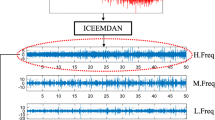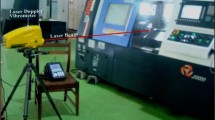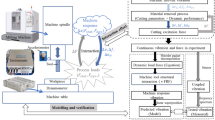Abstract
The vibrations on the cutting tool have a momentous influence for the surface quality of workpiece with respect to surface profile and roughness during the precision end-milling process. Singular spectrum analysis (SSA) is a new non-parametric technique of time series analysis and forecasting. The significant features of the cutting tool vibration signals from the sensors are extracted and transformed from the SSA-processed vibration signals. In the present study, SSA is applied to extract and transform the raw signals of the vibrations on the cutting tool for investigating the relationship between tool vibration and surface roughness in the precision end-milling process of hardened steel SCM440. In this experimental investigation, the spindle speed, feed rate, and cutting depth were chosen as the numerical factor; the cutting feed direction and holder type were regarded as the categorical factor. An experimental plan consisting of five-factor (three numerical plus two categorical) d-optimal design based on the response surface methodology was employed to carry out the experimental study. A micro-cutting test was conducted to visualize the effect of vibration of tooltip on the performance of surface roughness. With the experimental values up to 95% confidence interval, it is fairly well for the experimental results to present the mathematical models of the tool vibration and surface roughness. Results show that the effects of feed rate and cutting depth provide the reinforcement on the overall vibration to cause the unstable cutting process and exhibit the result of the worst machined surface. The amplitude of vibration signals along the cutting feed direction is generally larger than that along other direction. The spindle speed and tool holder type affect the stability of cutting tooltip during the cutting process.
Similar content being viewed by others
References
Chae J, Park SS, Freiheit T (2006) Investigation of micro-cutting operations. Int J Mach Tools Manuf 46:313–332
Tounsi N, Otho A (2000) Identification of machine-tool–workpiece system dynamics. Int J Mach Tools Manuf 40:1367–1384
Cowley A (1970) Structural analysis. Machine tool structures. Pergamon, Oxford
Marinescu I, Ispas C, Boboc D (2002) Handbook of machine tool analysis. Marcel Dekker, New York
Dimla DE Sr (2004) The impact of cutting conditions on cutting forces and vibration signals in turning with plane face geometry inserts. J Mater Process Technol 155–156:1708–1715
Thomas M, Beauchamp Y, Youssef AY, Masounave J (1996) Effect of tool vibration on surface roughness during lathe dry turning process. Comput Ind Eng 31(3–4):637–644
Mer A, Diniz AE (1994) Correlating tool wear, tool life, surface roughness and tool vibration in finish turning with coated carbide tools. Wear 173:137–144
Jang DY, Choi YG, Kim HG, Hsiao A (1996) Study of the correlation between surface roughness and cutting vibration to develop an online roughness measuring technique in hard turning. Int J Mach Tools Manuf 36(4):453–464
Abouelatta OB, Madl J (2001) Surface roughness prediction based on cutting parameters and tool vibrations in turning operations. J Mater Process Technol 118:269–277
Dimla DE (2002) The correlation of vibration signal features to cutting tool wear in a metal turning operation. Int J Adv Manuf Technol 19:705–713
Risbood KA, Dixit US, Sahasrabudhe AD (2003) Prediction of surface roughness and dimensional deviation by measuring cutting forces and vibrations in turning. J Mater Process Technol 132(1–3):203–214
Li HZ, Zeng H, Chen XQ (2006) An experimental study of tool wear and cutting force variation in the end milling of Inconel 718 with coated carbide inserts. J Mater Process Technol 180:296–304
Golyandina N, Nekrutkin V, Zhigljavsky A (2001) Analysis of time series structure—SSA and related techniques. Chapman &Hall/CRC, Boca Raton, pp 13–17
Salgado DR, Alonso FJ (2006) Tool wear detection in turning operations using singular spectrum analysis. J Mater Process Technol 171:451–458
Kilundu B, Dehombreux P, Chiementin X (2011) Tool wear monitoring by machine learning techniques and singular spectrum analysis. Mech Syst Signal Process 25:400–415
Myers RH, Montgomery DC (1995) Response surface methodology: process and product optimization using designed experiments. John Wiley and Sons, New York
Khuri AI, Cornell JA (1996) Response surfaces, designs and analyses. Marcel Dekker, New York
Puri AB, Bhattacharyya B (2005) Modeling and analysis of white layer depth in a wire-cut EDM process through response surface methodology. Int J Adv Manuf Technol 25:301–307
Lin BT, Jean MD, Chou JH (2007) Using response surface methodology with response transformation in optimizing plasma spraying coatings. Int J Adv Manuf Technol 34:307–315
Davim JP, Gaitonde VN, Karnik SR (2008) An investigative study of delamination in drilling of medium density fibreboard (MDF) using response surface models. Int J Adv Manuf Technol 37:49–57
Palanikumar K (2008) Application of Taguchi and response surface methodologies for surface roughness in machining glass fiber reinforced plastics by PCD tooling. Int J Adv Manuf Technol 36:19–27
Çaydaş U, Hasçalik A (2008) Modeling and analysis of electrode wear and white layer thickness in die-sinking EDM process through response surface methodology. Int J Adv Manuf Technol 38:1148–1156
Munda J, Bhattacharyya B (2008) Investigation into electrochemical micromachining (EMM) through response surface methodology based approach. Int J Adv Manuf Technol 35:821–832
Box GEP, Lucas HL (1959) Design of experiments in non-linear situations. Biometrika 46(1/2):77–90
Author information
Authors and Affiliations
Corresponding author
Rights and permissions
About this article
Cite this article
Chen, CC., Liu, NM., Chiang, KT. et al. Experimental investigation of tool vibration and surface roughness in the precision end-milling process using the singular spectrum analysis. Int J Adv Manuf Technol 63, 797–815 (2012). https://doi.org/10.1007/s00170-012-3943-4
Received:
Accepted:
Published:
Issue Date:
DOI: https://doi.org/10.1007/s00170-012-3943-4




